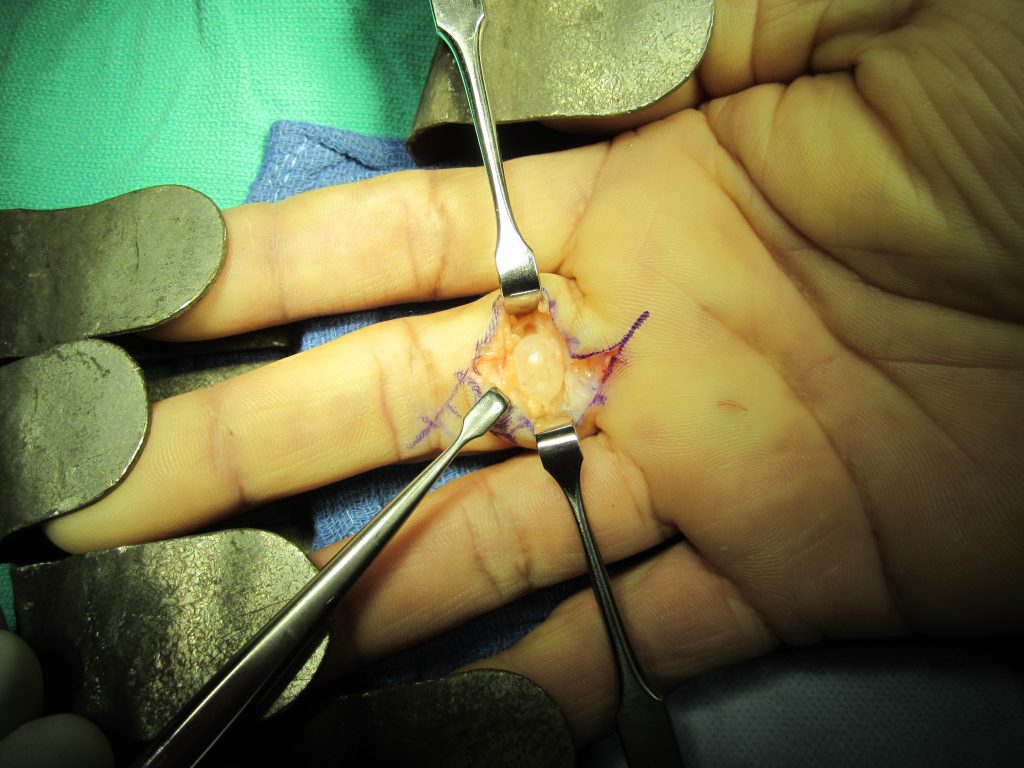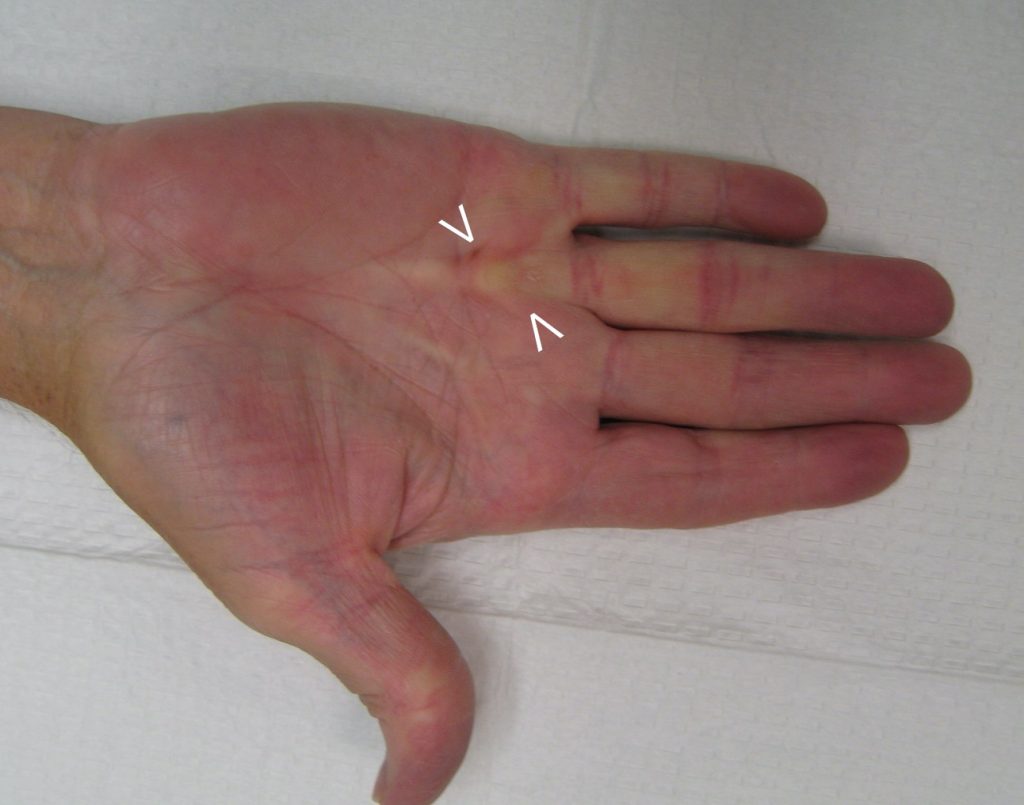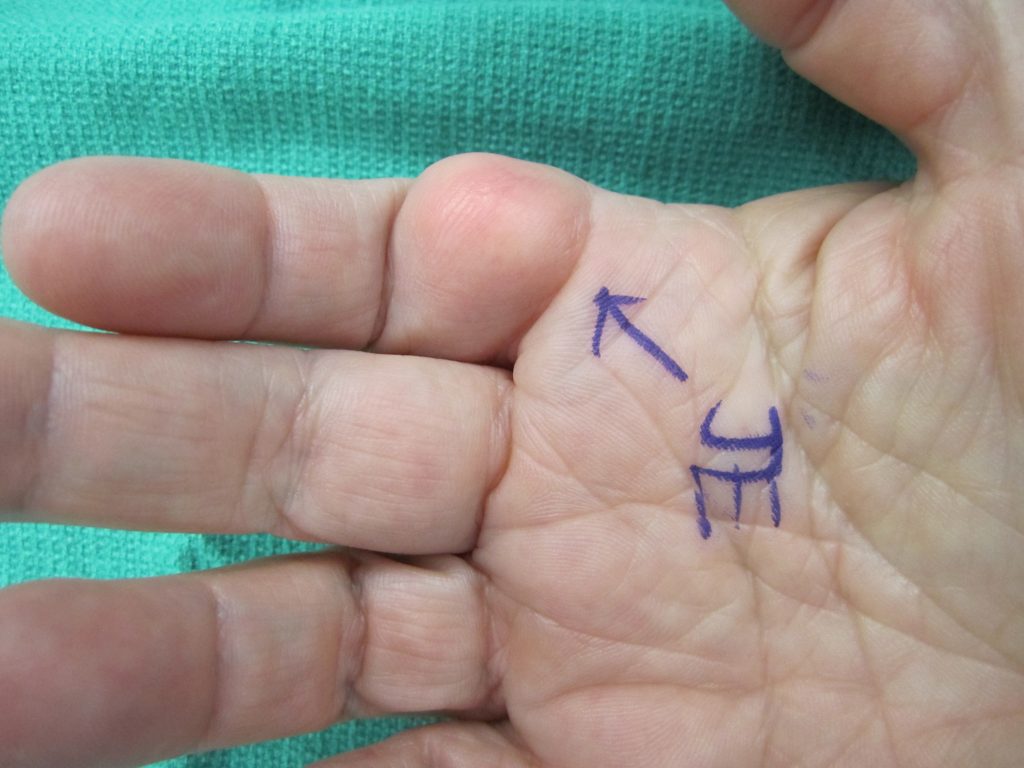Lumps and bumps are common in the palm of the hand. Patients should seek evaluation by a trained physician to make the diagnosis. Below are the most common causes of lumps in the palm.
Ganglion Cyst
The most common cause of a hand lump is a ganglion cyst. These are fluid filled sacs which come from the joint or tendon fluid in the hand. Ganglion cyst are not cancer. Occasionally the cysts will go away on their own. They often fluctuate in size. In other words they can be big one day, and smaller the next day. If the cyst is painful, it can be drained with a needle by a doctor or removed by a surgeon. Drainage of the cyst with a needle is a simple treatment, but the cyst comes back about 50% of the time. After surgery, the chance of recurrence is 5-10%. If the cyst is not painful or bothersome, it does not require treatment.

Dupuytren’s Nodule
Another very common cause for a lump in the palm is due to Dupuytren’s disease. These lumps are called Dupuytren’s nodules. Dupuytren’s nodules are made up of abnormal scar tissue. Dupuytren’s is more common in males of Caucasian ethnicity. Sometimes it is called Viking’s disease because it is prevalent in Scandinavian, Scotts-Irish, and Northern European populations where the Viking’s lived. In many cases the condition occurs in both hands and it runs in families. Most of the time the nodule is not painful, but occasionally it can be tender to the touch.

It is hard to predict if the nodule will cause functional problems with the hand in the future. One long-term study from Scandinavia showed that only 35% of patients with a nodule will develop a joint contracture in the finger. Another study showed that 10% of the palm nodules went away over time. In any case, patients should be evaluated by a trained physician to make the diagnosis and discuss treatment options.
Occasionally the palm nodules are painful to the touch, and these can be treated with steroid injections. Steroid injections have shown to reduce the thickness of the nodules and they can decrease the tenderness. There is no known cure for Dupuytren’s. Most hand surgeons in the United States do not recommend radiation treatment for this condition due to potential for side effects. If a joint contracture develops in the finger, a hand surgeon can be helpful to improve the finger range of motion and hand function. Surgical and non-surgical treatments are available.
Doctors do not know exactly what causes Dupuytren’s. Family history is a risk factor as well as diabetes, smoking, alcoholism, and some medications. Sometimes Dupuytren’s nodules arise after trauma to the hand or after hand surgery. In these cases, the nodules are not as likely to develop into cords or joint contractures, and they can go away.
Giant Cell Tumor of Tendon Sheath
Giant Cell Tumors are common tumors in the hand. These are typically firm and slow growing tumors. They can be painful if they press on a nerve or grow to a large size. They are not cancer. Sometimes an x-ray, ultrasound, or MRI is obtained to evaluate the hand tumor in more detail. Usually these are treated by a surgeon with surgical excision in the operating room. There is a 20-30% chance that the tumor comes back after surgery. The cause of these tumors is not known.
Epidermal Inclusion Cyst
Epidermal Inclusion Cysts are common following hand trauma or lacerations to the skin of the hand. These are usually slow growing and occasionally firm and tender. These cysts are made of up keratin material shed from skin cells within the lesion. This is a thick, white-yellow, cheese-like substance. Surgery is usually recommended for epidermal inclusion cysts. Recurrence of the cyst after surgery is very low.

There are several other causes for lumps in the palm including: lipomas, nerve tumors, neuromas, blood vessel tumors, and cancers. Please seek evaluation with a trained physician to make the diagnosis. Hand surgeons are experts in the diagnosis and treatment of hand lumps, bumps, cysts, and tumors.
If you are in the Raleigh, NC area, please call Raleigh Hand to Shoulder Center to schedule a consultation with Dr. John Erickson.
Outside of the clinic and operating room, Dr. Erickson enjoys painting, biking, and hiking. His artwork can be found online here.
